Business Environment (BBE) Report: Organizational Analysis and Scope
VerifiedAdded on 2023/01/03
|19
|5936
|32
Report
AI Summary
This report provides a detailed analysis of the business environment, focusing on various organizational types, including public, private, and voluntary sectors. It examines the size and scope of these organizations, using the NHS and IKEA as case studies. The report delves into the relationships between organizational functions, objectives, and structure, while also exploring the positive and negative impacts of the macro environment on business operations. Furthermore, it presents internal analyses, identifying strengths and weaknesses within organizations and correlating these with external macro factors. The report concludes with a comprehensive overview of the interrelation between strengths, weaknesses, and external macro factors within the context of IKEA and the NHS, providing insights into how different departments can enhance their working motivation and efficiency. The report also outlines the legal structure of public, private and voluntary organizations, and the objectives and missions of NHS, IKEA and British Red Cross.

1 BBE
Paraphrase This Document
Need a fresh take? Get an instant paraphrase of this document with our AI Paraphraser
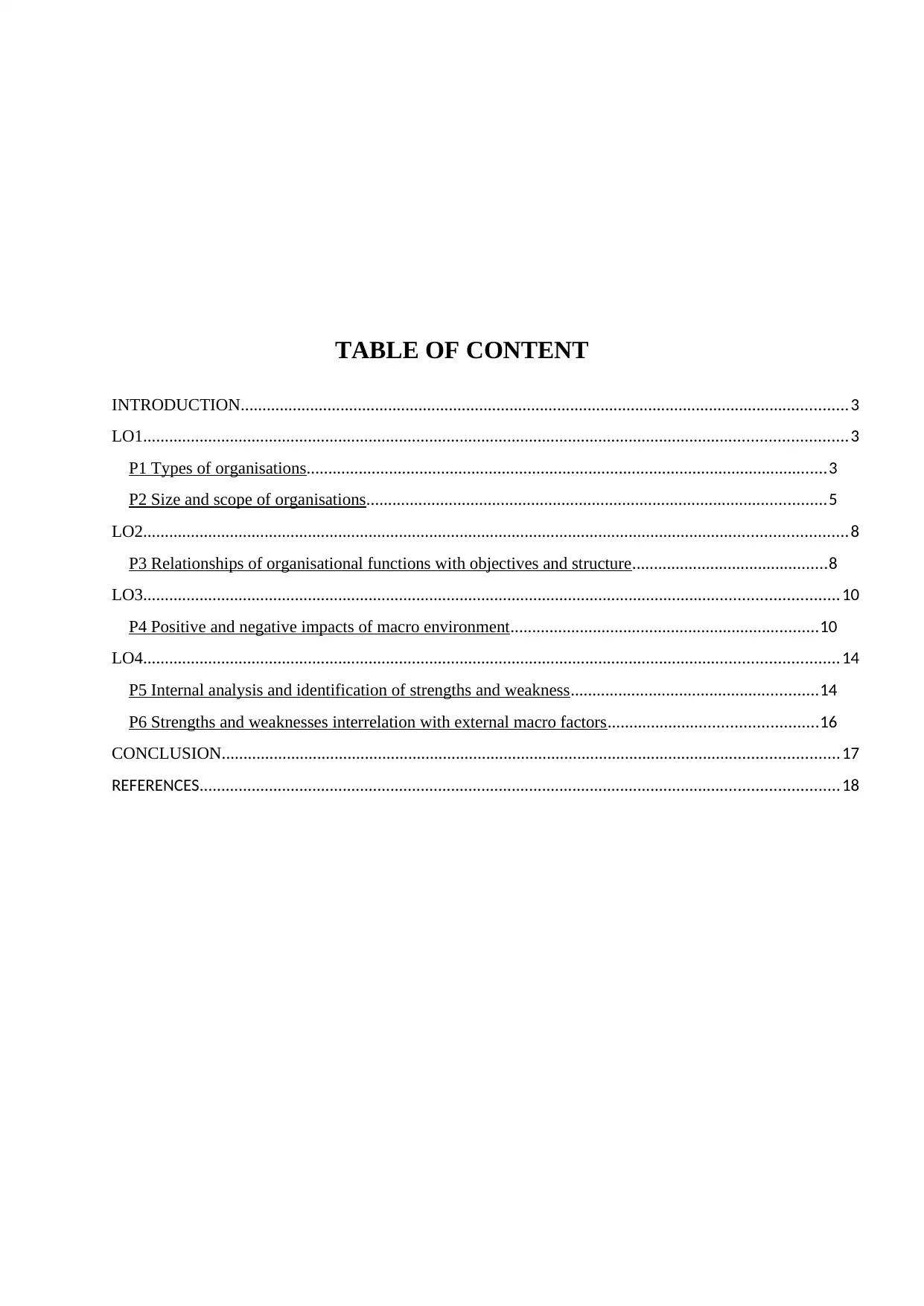
TABLE OF CONTENT
INTRODUCTION............................................................................................................................................3
LO1..................................................................................................................................................................3
P1 Types of organisations........................................................................................................................3
P2 Size and scope of organisations..........................................................................................................5
LO2..................................................................................................................................................................8
P3 Relationships of organisational functions with objectives and structure.............................................8
LO3................................................................................................................................................................10
P4 Positive and negative impacts of macro environment.......................................................................10
LO4................................................................................................................................................................14
P5 Internal analysis and identification of strengths and weakness.........................................................14
P6 Strengths and weaknesses interrelation with external macro factors................................................16
CONCLUSION..............................................................................................................................................17
REFERENCES...................................................................................................................................................18
INTRODUCTION............................................................................................................................................3
LO1..................................................................................................................................................................3
P1 Types of organisations........................................................................................................................3
P2 Size and scope of organisations..........................................................................................................5
LO2..................................................................................................................................................................8
P3 Relationships of organisational functions with objectives and structure.............................................8
LO3................................................................................................................................................................10
P4 Positive and negative impacts of macro environment.......................................................................10
LO4................................................................................................................................................................14
P5 Internal analysis and identification of strengths and weakness.........................................................14
P6 Strengths and weaknesses interrelation with external macro factors................................................16
CONCLUSION..............................................................................................................................................17
REFERENCES...................................................................................................................................................18
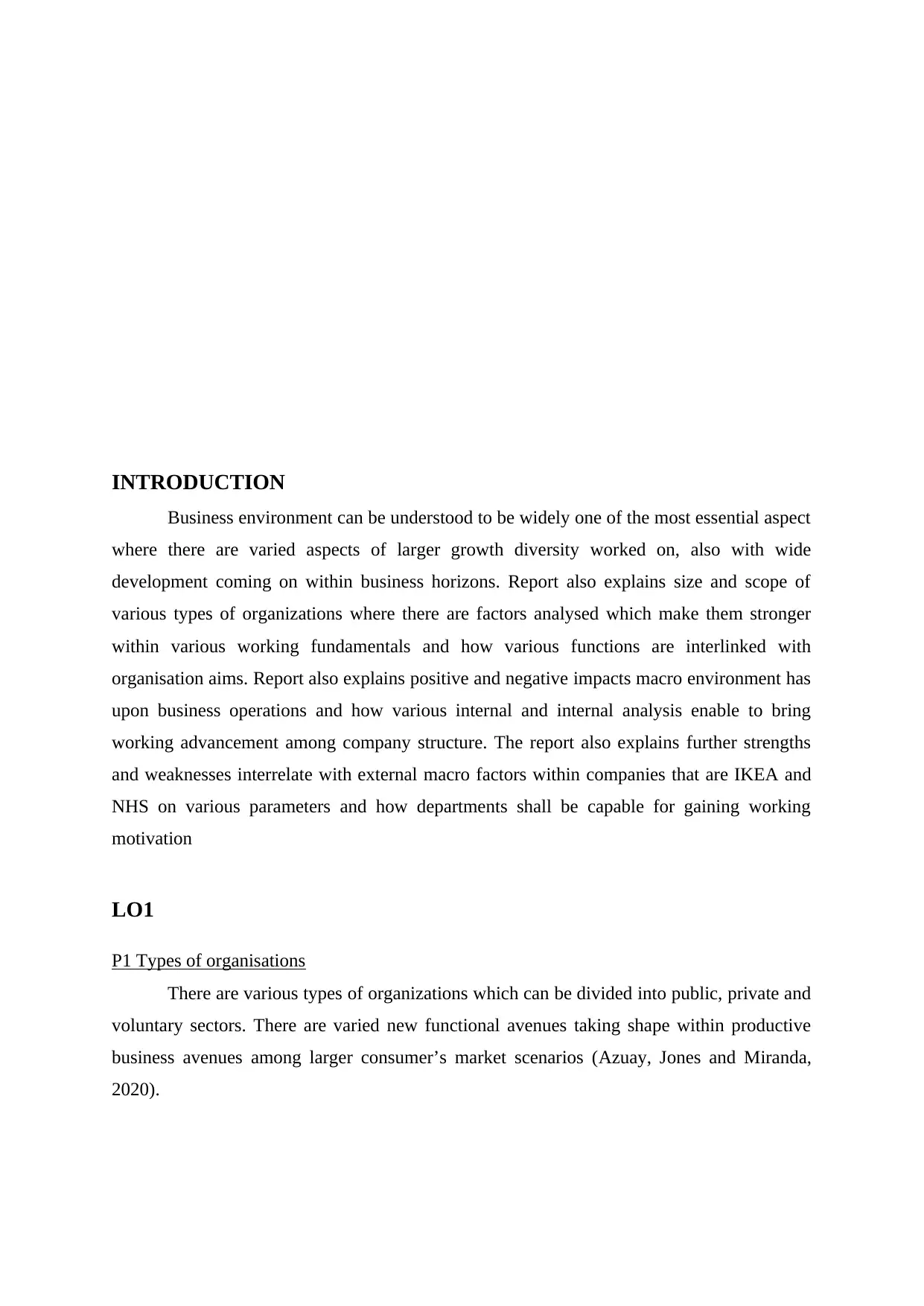
INTRODUCTION
Business environment can be understood to be widely one of the most essential aspect
where there are varied aspects of larger growth diversity worked on, also with wide
development coming on within business horizons. Report also explains size and scope of
various types of organizations where there are factors analysed which make them stronger
within various working fundamentals and how various functions are interlinked with
organisation aims. Report also explains positive and negative impacts macro environment has
upon business operations and how various internal and internal analysis enable to bring
working advancement among company structure. The report also explains further strengths
and weaknesses interrelate with external macro factors within companies that are IKEA and
NHS on various parameters and how departments shall be capable for gaining working
motivation
LO1
P1 Types of organisations
There are various types of organizations which can be divided into public, private and
voluntary sectors. There are varied new functional avenues taking shape within productive
business avenues among larger consumer’s market scenarios (Azuay, Jones and Miranda,
2020).
Business environment can be understood to be widely one of the most essential aspect
where there are varied aspects of larger growth diversity worked on, also with wide
development coming on within business horizons. Report also explains size and scope of
various types of organizations where there are factors analysed which make them stronger
within various working fundamentals and how various functions are interlinked with
organisation aims. Report also explains positive and negative impacts macro environment has
upon business operations and how various internal and internal analysis enable to bring
working advancement among company structure. The report also explains further strengths
and weaknesses interrelate with external macro factors within companies that are IKEA and
NHS on various parameters and how departments shall be capable for gaining working
motivation
LO1
P1 Types of organisations
There are various types of organizations which can be divided into public, private and
voluntary sectors. There are varied new functional avenues taking shape within productive
business avenues among larger consumer’s market scenarios (Azuay, Jones and Miranda,
2020).
⊘ This is a preview!⊘
Do you want full access?
Subscribe today to unlock all pages.

Trusted by 1+ million students worldwide
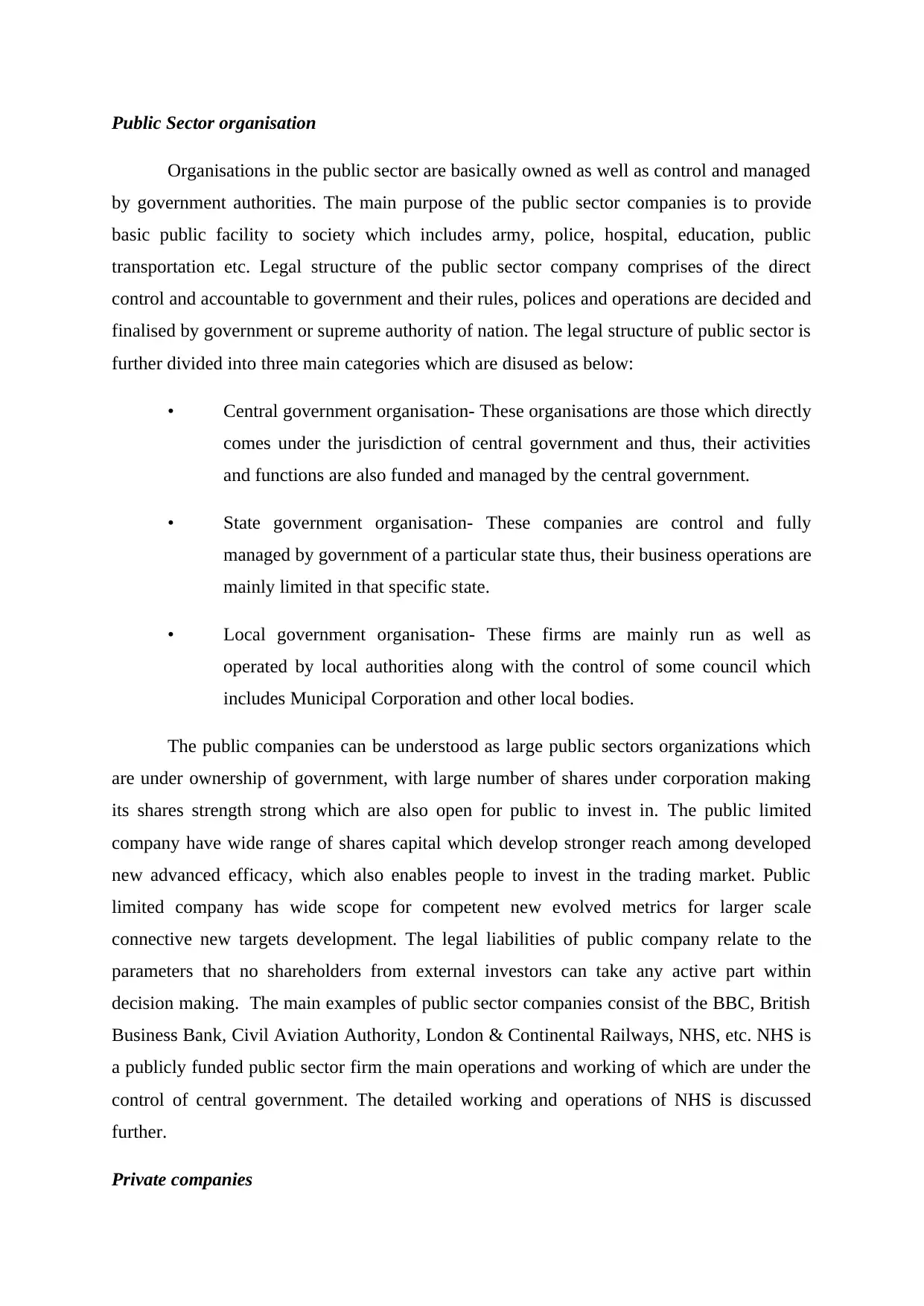
Public Sector organisation
Organisations in the public sector are basically owned as well as control and managed
by government authorities. The main purpose of the public sector companies is to provide
basic public facility to society which includes army, police, hospital, education, public
transportation etc. Legal structure of the public sector company comprises of the direct
control and accountable to government and their rules, polices and operations are decided and
finalised by government or supreme authority of nation. The legal structure of public sector is
further divided into three main categories which are disused as below:
• Central government organisation- These organisations are those which directly
comes under the jurisdiction of central government and thus, their activities
and functions are also funded and managed by the central government.
• State government organisation- These companies are control and fully
managed by government of a particular state thus, their business operations are
mainly limited in that specific state.
• Local government organisation- These firms are mainly run as well as
operated by local authorities along with the control of some council which
includes Municipal Corporation and other local bodies.
The public companies can be understood as large public sectors organizations which
are under ownership of government, with large number of shares under corporation making
its shares strength strong which are also open for public to invest in. The public limited
company have wide range of shares capital which develop stronger reach among developed
new advanced efficacy, which also enables people to invest in the trading market. Public
limited company has wide scope for competent new evolved metrics for larger scale
connective new targets development. The legal liabilities of public company relate to the
parameters that no shareholders from external investors can take any active part within
decision making. The main examples of public sector companies consist of the BBC, British
Business Bank, Civil Aviation Authority, London & Continental Railways, NHS, etc. NHS is
a publicly funded public sector firm the main operations and working of which are under the
control of central government. The detailed working and operations of NHS is discussed
further.
Private companies
Organisations in the public sector are basically owned as well as control and managed
by government authorities. The main purpose of the public sector companies is to provide
basic public facility to society which includes army, police, hospital, education, public
transportation etc. Legal structure of the public sector company comprises of the direct
control and accountable to government and their rules, polices and operations are decided and
finalised by government or supreme authority of nation. The legal structure of public sector is
further divided into three main categories which are disused as below:
• Central government organisation- These organisations are those which directly
comes under the jurisdiction of central government and thus, their activities
and functions are also funded and managed by the central government.
• State government organisation- These companies are control and fully
managed by government of a particular state thus, their business operations are
mainly limited in that specific state.
• Local government organisation- These firms are mainly run as well as
operated by local authorities along with the control of some council which
includes Municipal Corporation and other local bodies.
The public companies can be understood as large public sectors organizations which
are under ownership of government, with large number of shares under corporation making
its shares strength strong which are also open for public to invest in. The public limited
company have wide range of shares capital which develop stronger reach among developed
new advanced efficacy, which also enables people to invest in the trading market. Public
limited company has wide scope for competent new evolved metrics for larger scale
connective new targets development. The legal liabilities of public company relate to the
parameters that no shareholders from external investors can take any active part within
decision making. The main examples of public sector companies consist of the BBC, British
Business Bank, Civil Aviation Authority, London & Continental Railways, NHS, etc. NHS is
a publicly funded public sector firm the main operations and working of which are under the
control of central government. The detailed working and operations of NHS is discussed
further.
Private companies
Paraphrase This Document
Need a fresh take? Get an instant paraphrase of this document with our AI Paraphraser
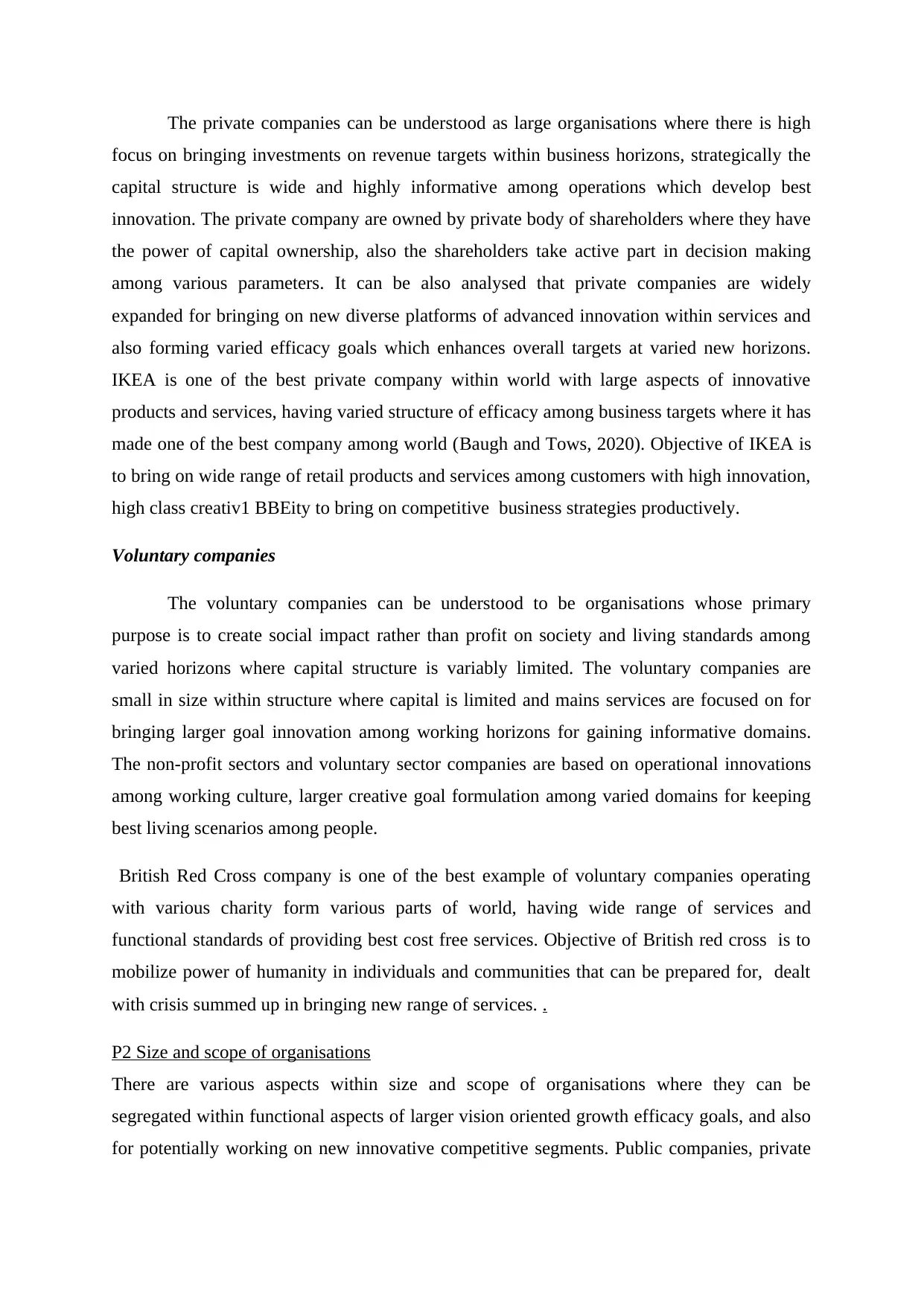
The private companies can be understood as large organisations where there is high
focus on bringing investments on revenue targets within business horizons, strategically the
capital structure is wide and highly informative among operations which develop best
innovation. The private company are owned by private body of shareholders where they have
the power of capital ownership, also the shareholders take active part in decision making
among various parameters. It can be also analysed that private companies are widely
expanded for bringing on new diverse platforms of advanced innovation within services and
also forming varied efficacy goals which enhances overall targets at varied new horizons.
IKEA is one of the best private company within world with large aspects of innovative
products and services, having varied structure of efficacy among business targets where it has
made one of the best company among world (Baugh and Tows, 2020). Objective of IKEA is
to bring on wide range of retail products and services among customers with high innovation,
high class creativ1 BBEity to bring on competitive business strategies productively.
Voluntary companies
The voluntary companies can be understood to be organisations whose primary
purpose is to create social impact rather than profit on society and living standards among
varied horizons where capital structure is variably limited. The voluntary companies are
small in size within structure where capital is limited and mains services are focused on for
bringing larger goal innovation among working horizons for gaining informative domains.
The non-profit sectors and voluntary sector companies are based on operational innovations
among working culture, larger creative goal formulation among varied domains for keeping
best living scenarios among people.
British Red Cross company is one of the best example of voluntary companies operating
with various charity form various parts of world, having wide range of services and
functional standards of providing best cost free services. Objective of British red cross is to
mobilize power of humanity in individuals and communities that can be prepared for, dealt
with crisis summed up in bringing new range of services. .
P2 Size and scope of organisations
There are various aspects within size and scope of organisations where they can be
segregated within functional aspects of larger vision oriented growth efficacy goals, and also
for potentially working on new innovative competitive segments. Public companies, private
focus on bringing investments on revenue targets within business horizons, strategically the
capital structure is wide and highly informative among operations which develop best
innovation. The private company are owned by private body of shareholders where they have
the power of capital ownership, also the shareholders take active part in decision making
among various parameters. It can be also analysed that private companies are widely
expanded for bringing on new diverse platforms of advanced innovation within services and
also forming varied efficacy goals which enhances overall targets at varied new horizons.
IKEA is one of the best private company within world with large aspects of innovative
products and services, having varied structure of efficacy among business targets where it has
made one of the best company among world (Baugh and Tows, 2020). Objective of IKEA is
to bring on wide range of retail products and services among customers with high innovation,
high class creativ1 BBEity to bring on competitive business strategies productively.
Voluntary companies
The voluntary companies can be understood to be organisations whose primary
purpose is to create social impact rather than profit on society and living standards among
varied horizons where capital structure is variably limited. The voluntary companies are
small in size within structure where capital is limited and mains services are focused on for
bringing larger goal innovation among working horizons for gaining informative domains.
The non-profit sectors and voluntary sector companies are based on operational innovations
among working culture, larger creative goal formulation among varied domains for keeping
best living scenarios among people.
British Red Cross company is one of the best example of voluntary companies operating
with various charity form various parts of world, having wide range of services and
functional standards of providing best cost free services. Objective of British red cross is to
mobilize power of humanity in individuals and communities that can be prepared for, dealt
with crisis summed up in bringing new range of services. .
P2 Size and scope of organisations
There are various aspects within size and scope of organisations where they can be
segregated within functional aspects of larger vision oriented growth efficacy goals, and also
for potentially working on new innovative competitive segments. Public companies, private

companies and voluntary companies can be analysed as follows (Cozened, Larmenier. and
Simon, 2017).
NHS (PUBLIC COMPANY)
A public organization is a joined substance that sells possession partakes in capital
business sectors. Albeit a chief group controls a public organization's business exercises, the
organization can offer portions of stock to thousands or even large number of financial
backers on the open market. The National Health Service (NHS) is the freely financed
medical care framework in England, and one of the four National Health Service frameworks
in the United Kingdom.
Its objectives: The main objective of NHS is to maintain the quality of the services in the
health and safety department inside UK.
Mission: The mission of the NHS since its establishment in 1948 is to cover all the health
care and nursing facility in UK. The NHS is focus on improving the quality of services and
reducing the expenditure of the patients as the organisation is already runs on public funds
Size: NHS comprises of four separate country's services which in total employees more than
1.5 million people with a budget of more than 136 billion euros. This work force comprises
of doctor, nurses and other such designations working under the umbrella of NHS. With such
high numbers the NHS is definitely a large public organisation.
Scope : Scope of NHS has been on a rise since it foundations. Some reports suggests that the
organisation takes the lead on the list of organisation that makes British people proud. In a
world of changing health issue and wellness concerns an organisation like NHS surely has a
responsibility to fulfil with high scopes of growth. The scope is national.
Legal structure
The legal structure of public limited organisation includes the following –
Government organisations – These can be ruled by central or regional government of the
country.
Departmental companies - In this kind of organisation, public enterprise is run by
government departments and hence they are governed by the ministry of government.
Public limited company - This organisation allows people to offer shares to public.
NHS is a public company and this allows it’s share to public.
Private company (IKEA)
The private companies in comparison with public companies have high focus on
shareholder’s profit targets pertaining new focus innovations among working horizons and
Simon, 2017).
NHS (PUBLIC COMPANY)
A public organization is a joined substance that sells possession partakes in capital
business sectors. Albeit a chief group controls a public organization's business exercises, the
organization can offer portions of stock to thousands or even large number of financial
backers on the open market. The National Health Service (NHS) is the freely financed
medical care framework in England, and one of the four National Health Service frameworks
in the United Kingdom.
Its objectives: The main objective of NHS is to maintain the quality of the services in the
health and safety department inside UK.
Mission: The mission of the NHS since its establishment in 1948 is to cover all the health
care and nursing facility in UK. The NHS is focus on improving the quality of services and
reducing the expenditure of the patients as the organisation is already runs on public funds
Size: NHS comprises of four separate country's services which in total employees more than
1.5 million people with a budget of more than 136 billion euros. This work force comprises
of doctor, nurses and other such designations working under the umbrella of NHS. With such
high numbers the NHS is definitely a large public organisation.
Scope : Scope of NHS has been on a rise since it foundations. Some reports suggests that the
organisation takes the lead on the list of organisation that makes British people proud. In a
world of changing health issue and wellness concerns an organisation like NHS surely has a
responsibility to fulfil with high scopes of growth. The scope is national.
Legal structure
The legal structure of public limited organisation includes the following –
Government organisations – These can be ruled by central or regional government of the
country.
Departmental companies - In this kind of organisation, public enterprise is run by
government departments and hence they are governed by the ministry of government.
Public limited company - This organisation allows people to offer shares to public.
NHS is a public company and this allows it’s share to public.
Private company (IKEA)
The private companies in comparison with public companies have high focus on
shareholder’s profit targets pertaining new focus innovations among working horizons and
⊘ This is a preview!⊘
Do you want full access?
Subscribe today to unlock all pages.

Trusted by 1+ million students worldwide
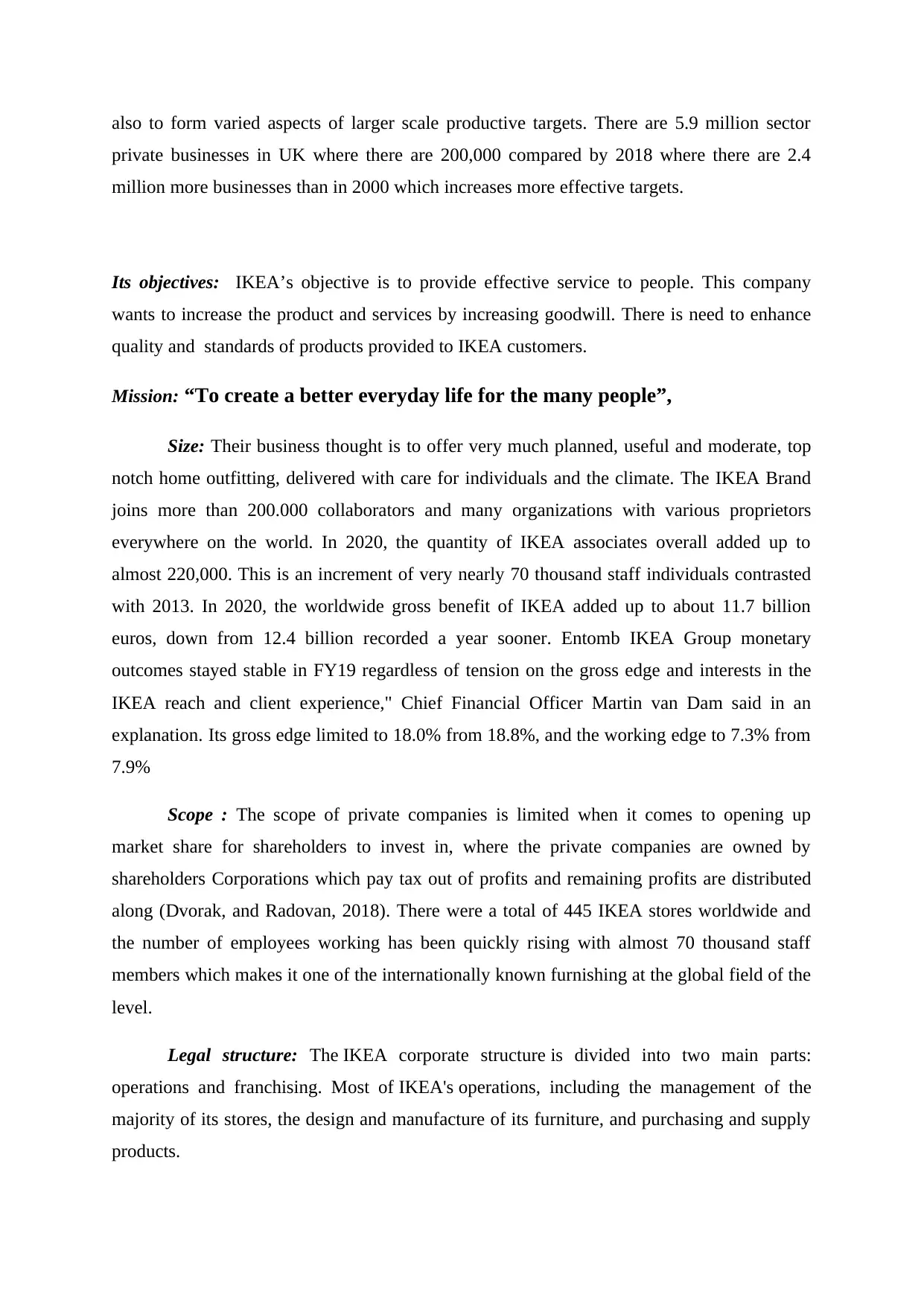
also to form varied aspects of larger scale productive targets. There are 5.9 million sector
private businesses in UK where there are 200,000 compared by 2018 where there are 2.4
million more businesses than in 2000 which increases more effective targets.
Its objectives: IKEA’s objective is to provide effective service to people. This company
wants to increase the product and services by increasing goodwill. There is need to enhance
quality and standards of products provided to IKEA customers.
Mission: “To create a better everyday life for the many people”,
Size: Their business thought is to offer very much planned, useful and moderate, top
notch home outfitting, delivered with care for individuals and the climate. The IKEA Brand
joins more than 200.000 collaborators and many organizations with various proprietors
everywhere on the world. In 2020, the quantity of IKEA associates overall added up to
almost 220,000. This is an increment of very nearly 70 thousand staff individuals contrasted
with 2013. In 2020, the worldwide gross benefit of IKEA added up to about 11.7 billion
euros, down from 12.4 billion recorded a year sooner. Entomb IKEA Group monetary
outcomes stayed stable in FY19 regardless of tension on the gross edge and interests in the
IKEA reach and client experience," Chief Financial Officer Martin van Dam said in an
explanation. Its gross edge limited to 18.0% from 18.8%, and the working edge to 7.3% from
7.9%
Scope : The scope of private companies is limited when it comes to opening up
market share for shareholders to invest in, where the private companies are owned by
shareholders Corporations which pay tax out of profits and remaining profits are distributed
along (Dvorak, and Radovan, 2018). There were a total of 445 IKEA stores worldwide and
the number of employees working has been quickly rising with almost 70 thousand staff
members which makes it one of the internationally known furnishing at the global field of the
level.
Legal structure: The IKEA corporate structure is divided into two main parts:
operations and franchising. Most of IKEA's operations, including the management of the
majority of its stores, the design and manufacture of its furniture, and purchasing and supply
products.
private businesses in UK where there are 200,000 compared by 2018 where there are 2.4
million more businesses than in 2000 which increases more effective targets.
Its objectives: IKEA’s objective is to provide effective service to people. This company
wants to increase the product and services by increasing goodwill. There is need to enhance
quality and standards of products provided to IKEA customers.
Mission: “To create a better everyday life for the many people”,
Size: Their business thought is to offer very much planned, useful and moderate, top
notch home outfitting, delivered with care for individuals and the climate. The IKEA Brand
joins more than 200.000 collaborators and many organizations with various proprietors
everywhere on the world. In 2020, the quantity of IKEA associates overall added up to
almost 220,000. This is an increment of very nearly 70 thousand staff individuals contrasted
with 2013. In 2020, the worldwide gross benefit of IKEA added up to about 11.7 billion
euros, down from 12.4 billion recorded a year sooner. Entomb IKEA Group monetary
outcomes stayed stable in FY19 regardless of tension on the gross edge and interests in the
IKEA reach and client experience," Chief Financial Officer Martin van Dam said in an
explanation. Its gross edge limited to 18.0% from 18.8%, and the working edge to 7.3% from
7.9%
Scope : The scope of private companies is limited when it comes to opening up
market share for shareholders to invest in, where the private companies are owned by
shareholders Corporations which pay tax out of profits and remaining profits are distributed
along (Dvorak, and Radovan, 2018). There were a total of 445 IKEA stores worldwide and
the number of employees working has been quickly rising with almost 70 thousand staff
members which makes it one of the internationally known furnishing at the global field of the
level.
Legal structure: The IKEA corporate structure is divided into two main parts:
operations and franchising. Most of IKEA's operations, including the management of the
majority of its stores, the design and manufacture of its furniture, and purchasing and supply
products.
Paraphrase This Document
Need a fresh take? Get an instant paraphrase of this document with our AI Paraphraser
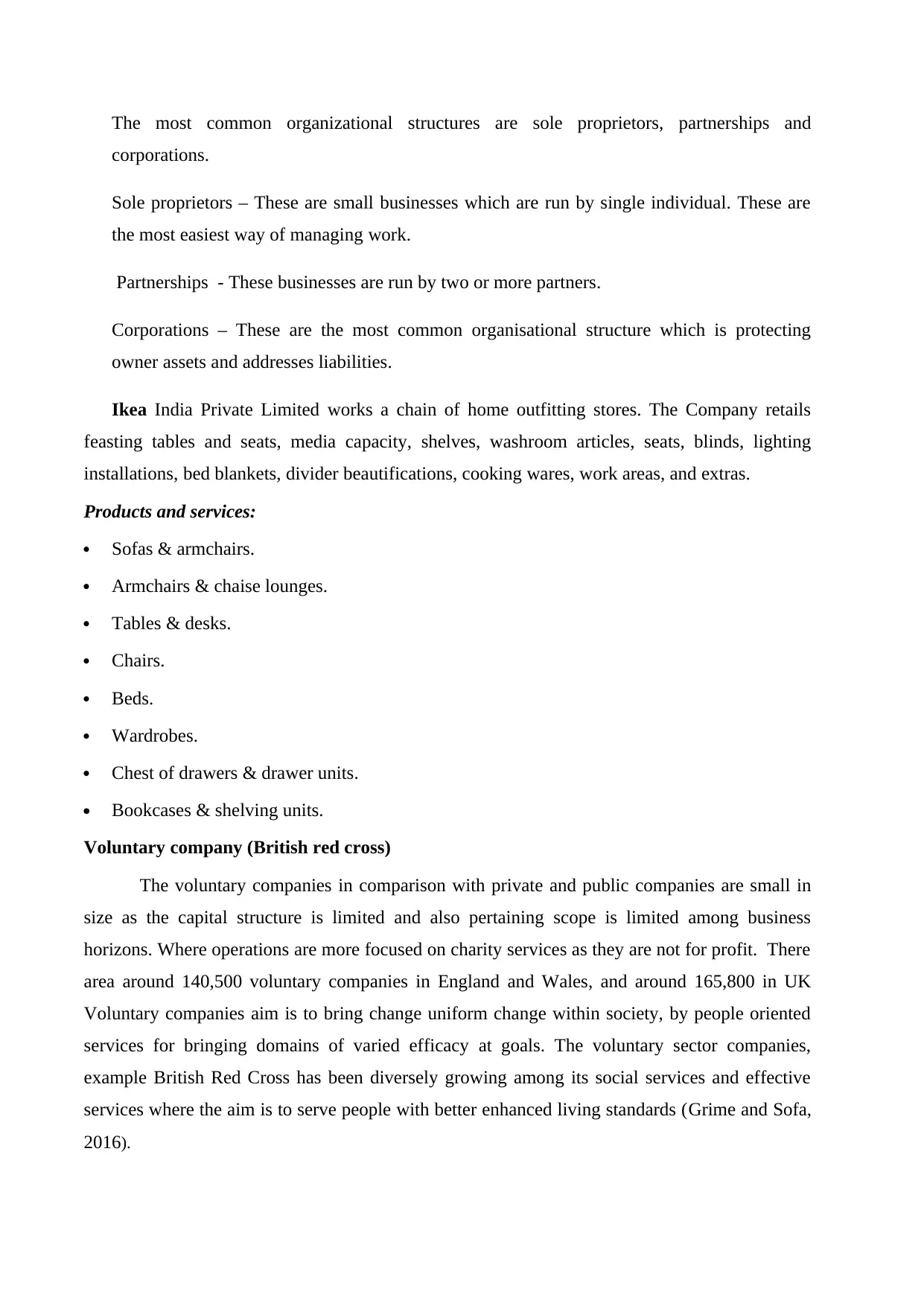
The most common organizational structures are sole proprietors, partnerships and
corporations.
Sole proprietors – These are small businesses which are run by single individual. These are
the most easiest way of managing work.
Partnerships - These businesses are run by two or more partners.
Corporations – These are the most common organisational structure which is protecting
owner assets and addresses liabilities.
Ikea India Private Limited works a chain of home outfitting stores. The Company retails
feasting tables and seats, media capacity, shelves, washroom articles, seats, blinds, lighting
installations, bed blankets, divider beautifications, cooking wares, work areas, and extras.
Products and services:
Sofas & armchairs.
Armchairs & chaise lounges.
Tables & desks.
Chairs.
Beds.
Wardrobes.
Chest of drawers & drawer units.
Bookcases & shelving units.
Voluntary company (British red cross)
The voluntary companies in comparison with private and public companies are small in
size as the capital structure is limited and also pertaining scope is limited among business
horizons. Where operations are more focused on charity services as they are not for profit. There
area around 140,500 voluntary companies in England and Wales, and around 165,800 in UK
Voluntary companies aim is to bring change uniform change within society, by people oriented
services for bringing domains of varied efficacy at goals. The voluntary sector companies,
example British Red Cross has been diversely growing among its social services and effective
services where the aim is to serve people with better enhanced living standards (Grime and Sofa,
2016).
corporations.
Sole proprietors – These are small businesses which are run by single individual. These are
the most easiest way of managing work.
Partnerships - These businesses are run by two or more partners.
Corporations – These are the most common organisational structure which is protecting
owner assets and addresses liabilities.
Ikea India Private Limited works a chain of home outfitting stores. The Company retails
feasting tables and seats, media capacity, shelves, washroom articles, seats, blinds, lighting
installations, bed blankets, divider beautifications, cooking wares, work areas, and extras.
Products and services:
Sofas & armchairs.
Armchairs & chaise lounges.
Tables & desks.
Chairs.
Beds.
Wardrobes.
Chest of drawers & drawer units.
Bookcases & shelving units.
Voluntary company (British red cross)
The voluntary companies in comparison with private and public companies are small in
size as the capital structure is limited and also pertaining scope is limited among business
horizons. Where operations are more focused on charity services as they are not for profit. There
area around 140,500 voluntary companies in England and Wales, and around 165,800 in UK
Voluntary companies aim is to bring change uniform change within society, by people oriented
services for bringing domains of varied efficacy at goals. The voluntary sector companies,
example British Red Cross has been diversely growing among its social services and effective
services where the aim is to serve people with better enhanced living standards (Grime and Sofa,
2016).

Its objectives: The Red Cross has objectives to bring assistance without
discrimination to the wounded on the battlefield, endeavours in its international and
national capacity, to prevent and alleviate human suffering wherever it may be found.
Its purpose is to protect life and health and to ensure respect for the human being.
Mission: The mission of the British Red Cross is to mobilise the power of
humanity so that individuals and communities can prepare for, deal with and
recover from a crisis, summed up by the strapline 'refusing to ignore people
in crisis'.
Size: British Red Cross employs nearly 4000 people which work in UK and overseas making
it one of the widely competent service organisation which is voluntary as also it is large term
of organisation.
Scope: Scope of British Red Cross: British Red Cross scope is connected to mobilise the
power of humanity so that individuals and communities can prepare for, deal with and
recover from a local scope in business.
Legal structure: British Red Cross is governed by a board of trustees where
board meets four times a year. The executive leadership team is responsible
for the day-to-day management of the organisation.
Products and services British Red Cross has delivered health and social care services.
We work with commissioners to provide valuable time-limited support to vulnerable
people across the UK.
LO2
P3 Relationships of organisational functions with objectives and structure
There are various relationships within organisational functions within objectives and
structure which enable us to analyse functional growth, diverse paradigms of functional
standards and larger vision oriented segments which deliver lager productive longer scale
targets at frame. It can be analysed that the overall targets at work within organisation
functions have strong interrelation within objectives and structure at for bringing on larger
goals formulation for bringing new functional standards innovation which also brings on
discrimination to the wounded on the battlefield, endeavours in its international and
national capacity, to prevent and alleviate human suffering wherever it may be found.
Its purpose is to protect life and health and to ensure respect for the human being.
Mission: The mission of the British Red Cross is to mobilise the power of
humanity so that individuals and communities can prepare for, deal with and
recover from a crisis, summed up by the strapline 'refusing to ignore people
in crisis'.
Size: British Red Cross employs nearly 4000 people which work in UK and overseas making
it one of the widely competent service organisation which is voluntary as also it is large term
of organisation.
Scope: Scope of British Red Cross: British Red Cross scope is connected to mobilise the
power of humanity so that individuals and communities can prepare for, deal with and
recover from a local scope in business.
Legal structure: British Red Cross is governed by a board of trustees where
board meets four times a year. The executive leadership team is responsible
for the day-to-day management of the organisation.
Products and services British Red Cross has delivered health and social care services.
We work with commissioners to provide valuable time-limited support to vulnerable
people across the UK.
LO2
P3 Relationships of organisational functions with objectives and structure
There are various relationships within organisational functions within objectives and
structure which enable us to analyse functional growth, diverse paradigms of functional
standards and larger vision oriented segments which deliver lager productive longer scale
targets at frame. It can be analysed that the overall targets at work within organisation
functions have strong interrelation within objectives and structure at for bringing on larger
goals formulation for bringing new functional standards innovation which also brings on
⊘ This is a preview!⊘
Do you want full access?
Subscribe today to unlock all pages.

Trusted by 1+ million students worldwide

diversity at frame. In context of IKEA, there are varied avenues within which larger scale
effective goal formulations are developed which can be discussed as follows:
Marketing and sales department functions: The marketing and sales management
department functions have high interrelation for bringing on larger informative goal
diversity within sales revenue targets, pertaining larger functional standards. IKEA
aims to productively reach among new horizons of innovative promotion goals
efficacy, keenly focus on bringing varied digital new diverse aspects which brings on
long scale profit targets. In context of IKEA, the primitive aspects of sales and
departments objectives enable us to analyse new functional innovation for larger
target growth domains, for larger target market reach among consumers and also for
developing keen innovations developed (Alsulayhim, 2019). The interrelation
between marketing and sales can be states as marketing strategies depends upon the
suggestions and objectives set by sales department.
Finance and production department: These two departments are interrelated in
context that if production department focuses on develop standard and quality
products then financial performance of the company can be managed properly. The
interrelation of finance and production departments enables us to analyse new
functional standards goals formatively on best targets at frame where capital
investments which are demanded for production innovation are planned by finance
department. IKEA aims to deliver quick growth efficacy scenarios within larger
domains goals in production departments targets for keeping up technical efficacy
scenarios for larger revenue profits developed. Finance and production departments
have larger new determining horizons pace, for keeping up varied goals efficacy
scenarios which profoundly evocatively develops higher determinants for keeping up
efficacy targets. Production aims to be evocatively stringent within IKEA developed
targets, for creative strengths scenarios and also for working horizons shift towards
innovation business standards.
HR departments and marketing: The HR departments and marketing interrelation
enable to form stronger vision oriented growth by serving customers with best
standards of larger new innovative business domains, for bringing on best marketing
aspects. HR department aims to bring on best informative consumer’s satisfaction
services among varied scenarios, for larger working horizons of innovative standards
effective goal formulations are developed which can be discussed as follows:
Marketing and sales department functions: The marketing and sales management
department functions have high interrelation for bringing on larger informative goal
diversity within sales revenue targets, pertaining larger functional standards. IKEA
aims to productively reach among new horizons of innovative promotion goals
efficacy, keenly focus on bringing varied digital new diverse aspects which brings on
long scale profit targets. In context of IKEA, the primitive aspects of sales and
departments objectives enable us to analyse new functional innovation for larger
target growth domains, for larger target market reach among consumers and also for
developing keen innovations developed (Alsulayhim, 2019). The interrelation
between marketing and sales can be states as marketing strategies depends upon the
suggestions and objectives set by sales department.
Finance and production department: These two departments are interrelated in
context that if production department focuses on develop standard and quality
products then financial performance of the company can be managed properly. The
interrelation of finance and production departments enables us to analyse new
functional standards goals formatively on best targets at frame where capital
investments which are demanded for production innovation are planned by finance
department. IKEA aims to deliver quick growth efficacy scenarios within larger
domains goals in production departments targets for keeping up technical efficacy
scenarios for larger revenue profits developed. Finance and production departments
have larger new determining horizons pace, for keeping up varied goals efficacy
scenarios which profoundly evocatively develops higher determinants for keeping up
efficacy targets. Production aims to be evocatively stringent within IKEA developed
targets, for creative strengths scenarios and also for working horizons shift towards
innovation business standards.
HR departments and marketing: The HR departments and marketing interrelation
enable to form stronger vision oriented growth by serving customers with best
standards of larger new innovative business domains, for bringing on best marketing
aspects. HR department aims to bring on best informative consumer’s satisfaction
services among varied scenarios, for larger working horizons of innovative standards
Paraphrase This Document
Need a fresh take? Get an instant paraphrase of this document with our AI Paraphraser

of departments which bring on evolving growth within competitive scenarios within
retail competitive industry. HR departments also focuses actively for bringing on
marketing training among employees for larger growth efficacy standard, which
potentially develops wider new functional governance of visionary services. It can be
also analysed that retail industry efficacy competitive goals at frame, there is varied
new competency framed among business efficacy targets at working domains which
competitively brings on larger new growth of operational metrics (Bioscopy, Connie
Jr, and McDonald IV, 2020). IKEA organizational structure is highly hierarchical
reflecting the large size of the business where functions of structure enables us to
analyse that aim of business plays strong role for new dynamic business efficacy. Its
interrelation with functions and objectives of brand have wide correlation with
hierarchical structure for dynamic competitive market reach.
IKEA organizational structure can be classified as hierarchical, reflecting massive
size of the business that integrates 422 IKEA stores in more than 50 markets where
interrelationship with various departments functions are widely essential.
NHS have a hierarchical structure which means that the chain of command from top
to bottom of the organisation is short and the span of control is wide.
British red cross: The organisation is divided into three regions, then into operational
areas, and then further into 'branches', which in most cases represent an administrative
county. Services provided by the British Red Cross are thus able to be adapted,
depending on the circumstances and needs of the local area.
Marketing and HR share comparative goals designated toward various crowds.
Advertising is responsible for the marking of the organization and conveying it to
customers. HR is answerable for business marking; guaranteeing the association is
seen appropriately by interior workers and outside up-and-comers.
LO3
P4 Positive and negative impacts of macro environment
The positive and negative impacts of macro environment is widely essential for
analysing work growth efficacy within the health care organisation. Macro environment can
be understood to be widely competitive among varied efficacy working scenarios where NHS
retail competitive industry. HR departments also focuses actively for bringing on
marketing training among employees for larger growth efficacy standard, which
potentially develops wider new functional governance of visionary services. It can be
also analysed that retail industry efficacy competitive goals at frame, there is varied
new competency framed among business efficacy targets at working domains which
competitively brings on larger new growth of operational metrics (Bioscopy, Connie
Jr, and McDonald IV, 2020). IKEA organizational structure is highly hierarchical
reflecting the large size of the business where functions of structure enables us to
analyse that aim of business plays strong role for new dynamic business efficacy. Its
interrelation with functions and objectives of brand have wide correlation with
hierarchical structure for dynamic competitive market reach.
IKEA organizational structure can be classified as hierarchical, reflecting massive
size of the business that integrates 422 IKEA stores in more than 50 markets where
interrelationship with various departments functions are widely essential.
NHS have a hierarchical structure which means that the chain of command from top
to bottom of the organisation is short and the span of control is wide.
British red cross: The organisation is divided into three regions, then into operational
areas, and then further into 'branches', which in most cases represent an administrative
county. Services provided by the British Red Cross are thus able to be adapted,
depending on the circumstances and needs of the local area.
Marketing and HR share comparative goals designated toward various crowds.
Advertising is responsible for the marking of the organization and conveying it to
customers. HR is answerable for business marking; guaranteeing the association is
seen appropriately by interior workers and outside up-and-comers.
LO3
P4 Positive and negative impacts of macro environment
The positive and negative impacts of macro environment is widely essential for
analysing work growth efficacy within the health care organisation. Macro environment can
be understood to be widely competitive among varied efficacy working scenarios where NHS
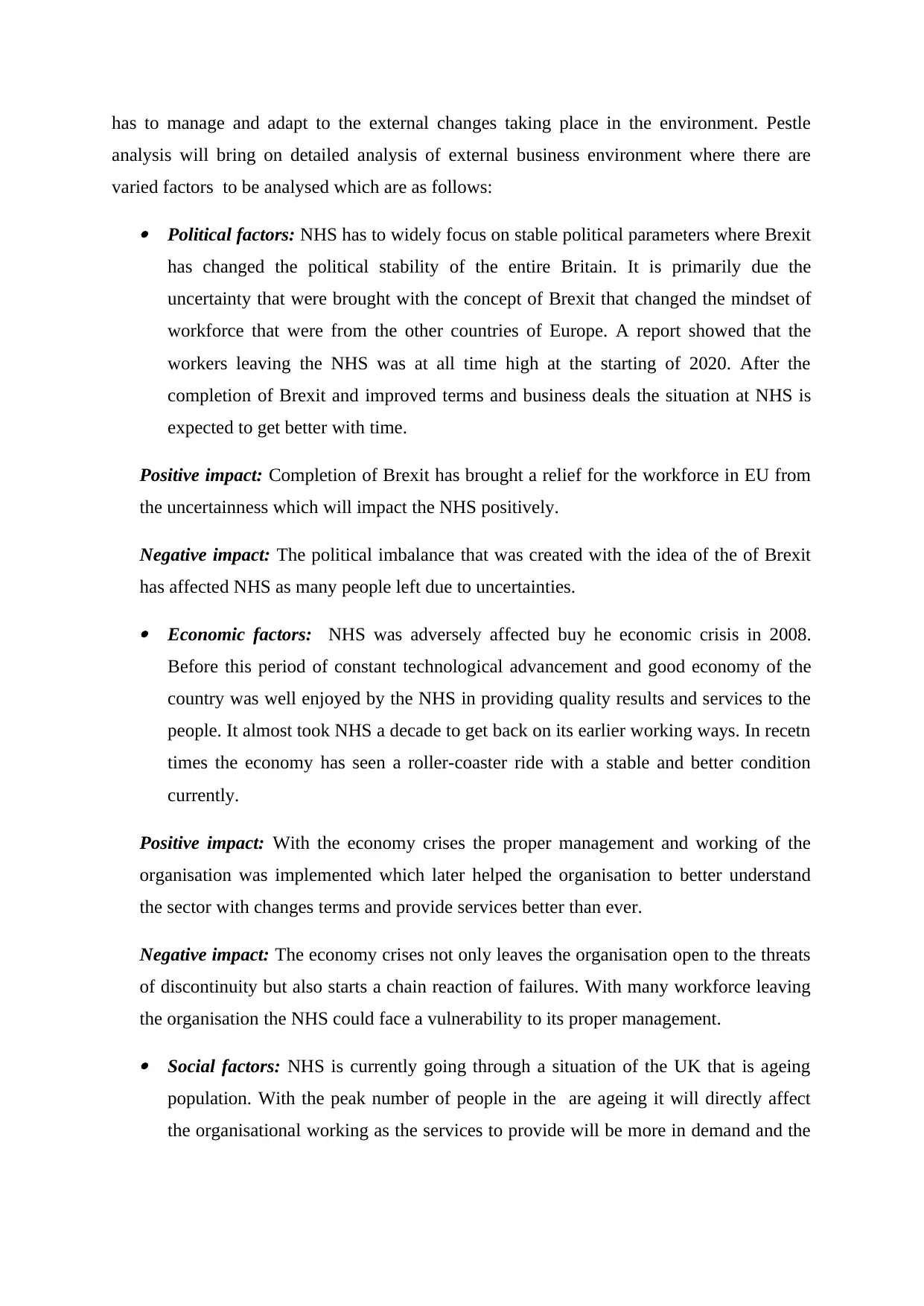
has to manage and adapt to the external changes taking place in the environment. Pestle
analysis will bring on detailed analysis of external business environment where there are
varied factors to be analysed which are as follows:
Political factors: NHS has to widely focus on stable political parameters where Brexit
has changed the political stability of the entire Britain. It is primarily due the
uncertainty that were brought with the concept of Brexit that changed the mindset of
workforce that were from the other countries of Europe. A report showed that the
workers leaving the NHS was at all time high at the starting of 2020. After the
completion of Brexit and improved terms and business deals the situation at NHS is
expected to get better with time.
Positive impact: Completion of Brexit has brought a relief for the workforce in EU from
the uncertainness which will impact the NHS positively.
Negative impact: The political imbalance that was created with the idea of the of Brexit
has affected NHS as many people left due to uncertainties.
Economic factors: NHS was adversely affected buy he economic crisis in 2008.
Before this period of constant technological advancement and good economy of the
country was well enjoyed by the NHS in providing quality results and services to the
people. It almost took NHS a decade to get back on its earlier working ways. In recetn
times the economy has seen a roller-coaster ride with a stable and better condition
currently.
Positive impact: With the economy crises the proper management and working of the
organisation was implemented which later helped the organisation to better understand
the sector with changes terms and provide services better than ever.
Negative impact: The economy crises not only leaves the organisation open to the threats
of discontinuity but also starts a chain reaction of failures. With many workforce leaving
the organisation the NHS could face a vulnerability to its proper management.
Social factors: NHS is currently going through a situation of the UK that is ageing
population. With the peak number of people in the are ageing it will directly affect
the organisational working as the services to provide will be more in demand and the
analysis will bring on detailed analysis of external business environment where there are
varied factors to be analysed which are as follows:
Political factors: NHS has to widely focus on stable political parameters where Brexit
has changed the political stability of the entire Britain. It is primarily due the
uncertainty that were brought with the concept of Brexit that changed the mindset of
workforce that were from the other countries of Europe. A report showed that the
workers leaving the NHS was at all time high at the starting of 2020. After the
completion of Brexit and improved terms and business deals the situation at NHS is
expected to get better with time.
Positive impact: Completion of Brexit has brought a relief for the workforce in EU from
the uncertainness which will impact the NHS positively.
Negative impact: The political imbalance that was created with the idea of the of Brexit
has affected NHS as many people left due to uncertainties.
Economic factors: NHS was adversely affected buy he economic crisis in 2008.
Before this period of constant technological advancement and good economy of the
country was well enjoyed by the NHS in providing quality results and services to the
people. It almost took NHS a decade to get back on its earlier working ways. In recetn
times the economy has seen a roller-coaster ride with a stable and better condition
currently.
Positive impact: With the economy crises the proper management and working of the
organisation was implemented which later helped the organisation to better understand
the sector with changes terms and provide services better than ever.
Negative impact: The economy crises not only leaves the organisation open to the threats
of discontinuity but also starts a chain reaction of failures. With many workforce leaving
the organisation the NHS could face a vulnerability to its proper management.
Social factors: NHS is currently going through a situation of the UK that is ageing
population. With the peak number of people in the are ageing it will directly affect
the organisational working as the services to provide will be more in demand and the
⊘ This is a preview!⊘
Do you want full access?
Subscribe today to unlock all pages.

Trusted by 1+ million students worldwide
1 out of 19
Related Documents
Your All-in-One AI-Powered Toolkit for Academic Success.
+13062052269
info@desklib.com
Available 24*7 on WhatsApp / Email
![[object Object]](/_next/static/media/star-bottom.7253800d.svg)
Unlock your academic potential
Copyright © 2020–2025 A2Z Services. All Rights Reserved. Developed and managed by ZUCOL.





